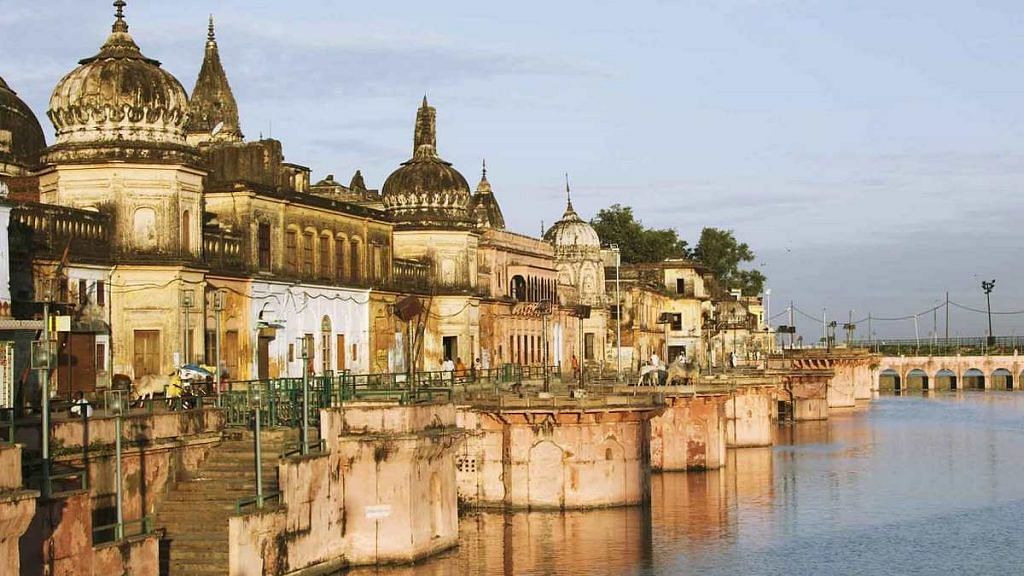Front Page
The historic Supreme Court verdict on the long-standing Ayodhya title suit case has been welcomed by newspapers Sunday, which seek closure to the contentious issue.
There has been predictably extensive coverage of the ruling across mainstream newspapers like the Hindustan Times and The Telegraph, that have dedicated their entire front pages to it. The judgment dominates the other newspapers as well and as many as 4-5 of the inside pages of most have focussed on it — TOI has a whopping 7 pages talking about it.
The Times of India: TOI chooses a bold, capitalised page 1 headline, which is also a pun “Ram Mandir within site”. Its photograph has individuals of different faiths celebrating the verdict outside the Supreme Court.
“A five-judge Supreme Court bench…settled the centuries-old Hindu-Muslim dispute that had been in courts for 70 years,” read the first line of its report. TOI terms the move a “balancing act”.
It also reports the bench’s comments on the demolition of the Babri Masjid — SC “emphatically said the communal riot that caused damage to the domes of Babri Masjid in 1934, its desecration on the night of December 22, 1949 by placing of idols, and the demolition on December 6, 1992 were illegal acts”.
A report from Ayodhya focuses on the festivities by some Hindu groups — “Second Diwali, say Ayodhya devotees with songs & sweets”.
TOI also speculates on the author of the verdict and concludes it carried the distinct style of Justice D.Y. Chandrachud.
Hindustan Times: HT’s overarching front page headline reads “Temple set in stone”. The accompanying photograph is the Ram Janmabhoomi Nyas workshop in Ayodhya that had bricks engraved with the words Shri Ram.
It writes, “The move was celebrated by hundreds of millions around the country although some Muslim parties questioned the verdict”. It adds that the verdict “ticks off another item on the checklist of the” BJP. Interestingly, the paper does not mention the Babri Masjid demolition at all, except a quote from the verdict.
Prime Minister Narendra Modi’s reaction to the verdict features on Page 1 — “Fear, bitterness and negativity have no place in new India.”
HT also carries a retrospective report with the headline — “136 years on, what order means for India”.
The Indian Express: “Temple gets site, mosque a plot”, writes Express, adding in its strap line: “5 judge unanimous on Ayodhya, call Babri razing illegal”.
It also highlights Congress reactions and its shift on the issue — “Rebuilding Babri Masjid to welcoming Ram temple, how Cong recalibrates”. Express says that Congress “appeared to be circumspect and wary of the political fallout of the verdict”.
The Hindu: True to form, Hindu maintains a straight face: “Temple at disputed site, mosque within Ayodhya, rules SC”. A special report adds that the “UP Sunni Central Waqf board will not go in for a review of the…verdict”.
Hindu also notes that while the Hindus in Ayodhya celebrated, the order “triggered a sense of dejection among the Muslim community of Faizabad-Ayodhya”.
The Telegraph: The newspaper makes its point: “In the name of Ram, the site is now HINDU-STHAN”. It branches out beyond the verdict and records the reactions of academics and other SC judges on the issue.
OPINION
Express: The verdict brought closure and a solution “situated in justice and due process”, writes Express. The unanimity of the five-judge Constitution bench led by Chief Justice of India Ranjan Gogoi is not an “incidental artefact of the ruling”, but part of its “essence”. But even this unanimous verdict triggers questions as the task before the court was “impossibly fraught”.
It goes on to say the final judgment invoked the constitutional freedoms and underlined that the case could not be established “on the basis of faith and belief”. The final settlement is of a “bare title suit”, which begs the question — “could the act of judgment have been more an act of imagination of a more equal justice?” One thing, however, is certain that the SC verdict should be taken forward and “built upon by all stakeholders”.
Telegraph: It writes that the Supreme Court has addressed the desecration of the Babri Masjid as an infringement of the law, and said the investigation by the CBI against the offenders must be expedited. A “further delay” in justice would “seriously undermine the claim of the arbitration being fair”.
The Ayodhya case and its verdict reveal certain “singular features” — a “tiny patch of land” inflicted “serious damage to the fabric of the country”. Much of this must be attributed to the “majoritarian political project” that had chosen to “piggyback” on the Ayodhya movement.
The Ayodhya dispute represented a title deed dispute, hence religious sentiments had no place in the matter. The SC verdict is supposed to bring closure, but this can only happen if “sympathisers of the Hindu fraternity choose to act responsibly”, Telegraph adds.
